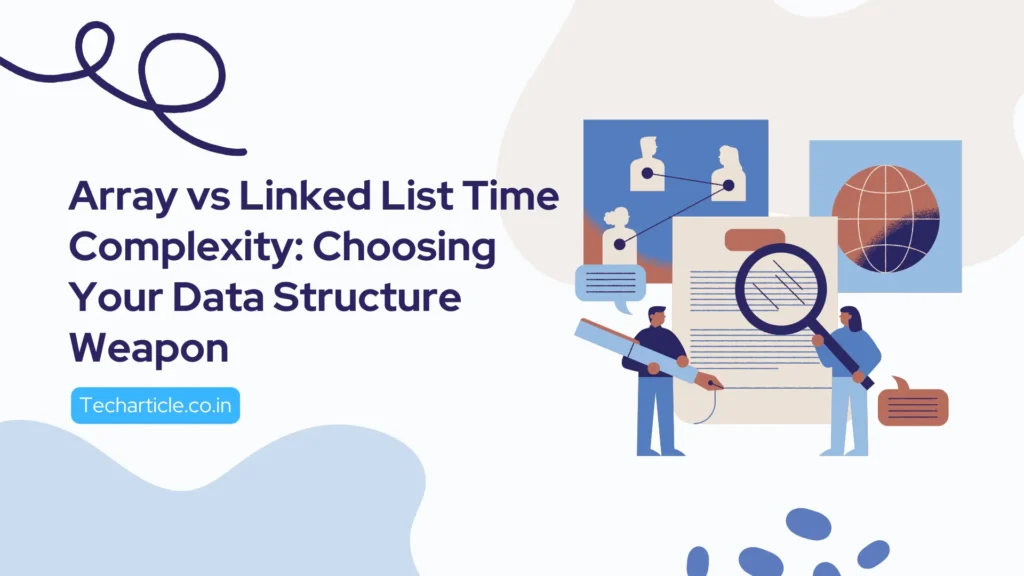
You’ve learned the basics of arrays and linked lists. You know one has its data in a contiguous block, and the other uses nodes scattered in memory. But when it comes to real-world use, how do you actually choose? The answer lies in understanding the array vs linked list time complexity.
This deep dive into array vs linked list time complexity will equip you to make the right architectural decision for your code. We’ll break down the performance of common operations with clear examples and a handy comparison table.
The Core Difference: Contiguous vs Scattered
The fundamental difference between these two data structures dictates their performance.
An array is a single, fixed-size chunk of memory. Knowing the memory address of the first element lets you instantly calculate the address of any other element.
A singly linked list is a chain of nodes. Each node holds its data and a pointer to the next node in the sequence. There is no direct path to a random node; you must traverse the chain link by link.
This simple distinction is the reason for all the performance differences we’re about to explore.
Accessing Elements: The Random Access King
Need to grab the 500th element? This is where the array shines.
Array (Java):
int[] numbers = {10, 20, 30, 40, 50};
int element = numbers[2]; // Instantly gets 30. Time: O(1)Array (Python):
numbers = [10, 20, 30, 40, 50]
element = numbers[2] # Instantly gets 30. Time: O(1)Time Complexity: O(1) – Constant Time. The computer performs a simple calculation to jump directly to the memory location.
Linked List (Java):
// First, you'd need to traverse to the index
Node current = head;
for (int i = 0; i < desiredIndex; i++) {
if (current == null) throw new IndexOutOfBoundsException();
current = current.next;
}Linked List (Python):
# A simplified traversal example
current = head
index = 0
desired_index = 2
while current is not None and index < desired_index:
current = current.next
index += 1
if current is not None:
element = current.data # Finally got the data!Time Complexity: O(n) – Linear Time. In the worst case, you might have to walk through every single node to find the one you want.
Verdict: For frequent random access by index, the array is the undisputed winner.
Insertions and Deletions: The Flexible Challenger
This is the linked list’s time to shine. Adding or removing a node from the beginning or middle of a list is incredibly efficient.
Inserting at the Head (Linked List):
- Create a new node.
- Set its next pointer to the current head.
- Update the head to point to the new node.
Time Complexity: O(1) – Constant Time. It doesn’t matter how big the list is; it’s always three simple steps.
Inserting in the Middle (Linked List):
- Traverse to the node just before the desired position (O(n) time).
- Rearrange the pointers. This is a constant-time operation once you’re there.
Overall Time Complexity: O(n). The traversal is the expensive part.
Now, look at an array. Inserting at the beginning or middle is costly because you must shift all subsequent elements to make space.
Inserting in an Array (Java):
// This requires manually shifting elements, a costly operation
int[] newArray = new int[oldArray.length + 1];
// ... code to copy elements and shift them to make space ...Inserting in an Array (Python):
While Python’s list.insert(i, item) is simple; under the hood, it must perform the same shifting operation.
my_list = [10, 20, 30, 40]
my_list.insert(1, 99) # -> [10, 99, 20, 30, 40]
# Internally, elements 20, 30, 40 all had to be shifted right.Time Complexity: O(n). In the worst case (inserting at index 0), you must shift every single element.
Verdict: For frequent additions and removals, especially at the beginning, the linked list has a significant advantage.
The Handy Comparison Table
| Operation | Array | Linked List | Winner |
| Access (by index) | O(1) | O(n) | Array |
| Insert/Delete at Head | O(n) (requires shift) | O(1) | Linked List |
| Insert/Delete in Middle | O(n) (requires shift) | O(n) (traversal) + O(1) | Tie (Theor.)* |
| Insert/Delete at Tail | O(1) (if space exists) / O(n) (if resizing) | O(n) (must traverse to end) | Array |
| Space (Overhead) | Minimal (just data) | Higher (data + pointers) | Array |
Theoretical time is the same, but the “constant factors” of pointer manipulation in a linked list are often faster than shifting many array elements in memory.
So, Which One Should You Use?
Choose an array (or a dynamic array like Python’s list or Java’s ArrayList) when:
- You need frequent random access to elements by their index.
- You know the number of elements in advance (or the dynamic array’s occasional resizing cost is acceptable).
- Memory usage is a critical concern.
- You are iterating over all elements, as arrays have excellent cache locality, making iterations very fast.
Choose a linked list when:
- You need constant-time insertions/deletions from the beginning of the list (e.g., implementing a stack or queue).
- The size of your list is highly dynamic and unpredictable. You can add nodes without ever worrying about pre-allocating space or resizing.
- You will be making many additions and removals in the middle of the list once you are already at that location (e.g., you are traversing anyway and won’t need to traverse again to find the position).
Understanding the array vs linked list time complexity is not just academic. It’s a fundamental skill that allows you to write efficient, scalable, and powerful software. Choose wisely.
Here are a few links to some of the important data structure topics:
A Guide to Decision Tree Classifier Hyperparameter Tuning
How to Reverse a Linked List Iteratively: A Step-by-Step Guide
How to Implement Graph in Python: A Clear and Engaging Guide
How to Solve Two Sum Problem: The Ultimate Guide
